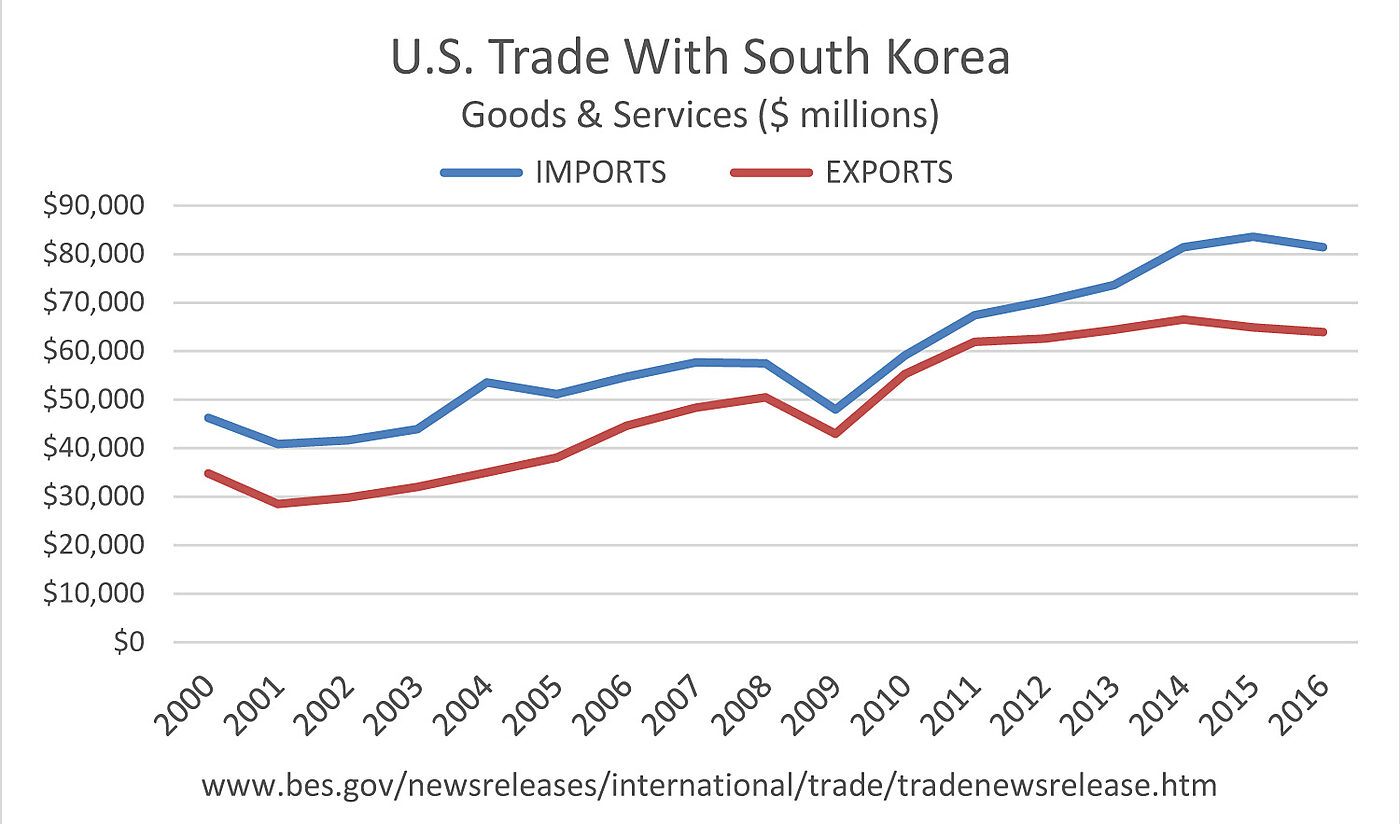The Wall Street Journal reports: “Mr. Trump’s nominee for U.S. Trade Representative singled out Mexico and South Korea during his Senate confirmation hearing as sparking American trade deficits. ‘In some cases, the rules don’t seem to be working as well as others,’ Robert Lighthizer said. Critics say the deal has led to a flood of South Korean cars, auto parts, memory chips, motors and pumps into the U.S., weighing on American competitors and jobs. A U.S. Trade Representative report this month said the pact… doubled the U.S. trade deficit in goods with South Korea.”
National Trade Council boss Peter Navarro has likewise claimed “We lost 100,000 jobs because of that South Korean deal. Our trade deficit has doubled, and, more importantly, 75 percent of the damage that has been caused by that deal has been to the auto industry itself, which, of course, is based in Michigan.”
Navarro, Lighthizer and the Journal’s unnamed critics are entirely wrong about the March 15, 2012 Korea/U.S. Free Trade Agreement (KORUS).
KORUS could not possibly have “led to a flood of South Korean… memory chips, motors and pumps into the U.S.” because memory chips were already duty-free before that FTA, and so were motors (HS code 8501) and pumps (8413).
KORUS could not possibly explain the post-recession 2010–2015 rise in U.S. imports from South Korea because most U.S. tariffs were scheduled to be reduced from 2016 to 2021 – not from 2010 to 2015.
KORUS had precisely zero effect on U.S. imports of Hyundai and Kia vehicles before 2016 because the U.S. tariff on Korean cars (HS code 8703) was 2.5% before KORUS and remained at 2.5% through 2015. Ironically, when U.S. tariffs on autos and other products finally did come down in 2016, total U.S. imports from South Korea fell 2.6% (by $1.9 billion).
The Korean tariff on imports of U.S. cars was cut from 8% in 2012 to 4% in 2015 and zero in 2016 and a 10% Korean tariff on U.S. trucks was eliminated. Even before Korea cut its tariff on U.S. cars to zero in 2016, U.S. exports of cars to So. Korea tripled from $418 million in 2011 to $1.3 billion in 2015, according to the USTR. Incidentally the USTR also notes that “Korea is currently our fifth-largest market for agricultural exports thanks to KORUS,” with farm exports up 208% from 2011 to 2015.
What has been most changed about the auto industry since KORUS is that South Korea exported a sizable share of its auto industry to the United States, displacing previous Korean imports and adding to U.S. auto exports. More than half the Hyundais sold in the U.S. are now assembled in Alabama, and more than 40% of Kias in Georgia (contrary to Peter Navarro, 82.5% of U.S. auto industry jobs are not in Michigan). The Hyundai Santa Fe and Kia Sorento have 67% domestic content. Hyundai has invested $2.8 billion in the U.S. and plans to add $3.1 billion more.
As the Graph shows, U.S. routinely ran sizable trade deficits with South Korea long before the FTA (and the U.S. routinely runs surpluses with other FTA countries, Australia and Singapore). The U.S. trade deficit with South Korea and other countries came way down in 2009–2011 because deep recessions always slash U.S. imports, particularly industrial imports.
The graph includes services which, like farm products, were an important part of the deal. The U.S. trade surplus in services with Korea rose from $6.9 billion in 2011 to $10.7 billion in 2016. With services included, U.S. imports from South Korea did not rise at all from 2014 to 2016 ($81.4 billion in both years), and goods imports fell in 2016.
South Korea’s imports of goods from the U.S. rose from $29.7 billion in 2009 to $46.3 billion by 2014 before falling 8.4%to $42.4 billion in 2016. Even with services included, South Korea’s imports from the U.S. fell from $66.5 billion to $63.9 billion since 2014.
KORUS could not possibly have had anything to do with the 2014–2016 drop in Korean imports from the U.S. because that agreement lowered rather than raised Korean tariffs.
South Korea’s demand for imports weakened because annual growth of industrial GDP fell to 2.5% from 2012 to 2015 – down sharply from a 6% pace from 2000 to 2011. One reason for Korea’s post-2014 import slump is that China’s imports from South Korea fell from more than $20 billion in October 2014 to $10–12 billion recently.
The Trump Administration’s top trade advisers are entirely wrong about what happened when with respect to trade between the U.S. and South Korea. KORUS had no effect at all on U.S. imports of auto, chips, motors or pumps between 2009 and 2015, because the U.S. auto tariff was unchanged until 2016 (when overall U.S. imports fell) and most other industrial products were already tariff-free before KORUS.
The Korea‑U.S. trade deficit in goods did not rise from 2011 to 2015 (or fall in 2016) because of U.S. auto tariff cuts in 2016, but because the U.S. economy strengthened after 2010 and the Korean economy weakened after 2014.

